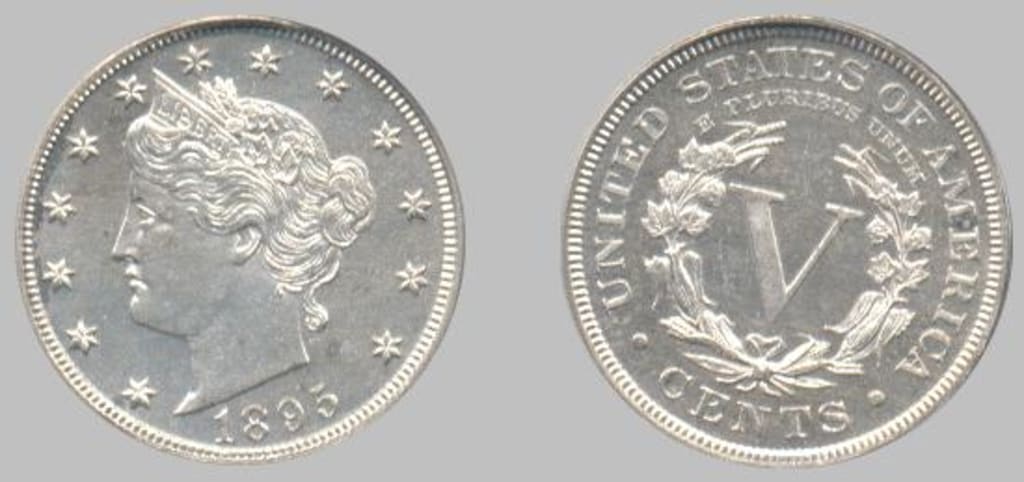
In 1883, the new nickel continued flaunting the face of Liberty into the American consciousness, but because of its size and design, it also brought a plague upon the Federal Mint, causing it to shut down for a spell.
The Josh Tatum Story
In January of 1883, the United States Mint began striking a new five-cent piece, or nickel, which was to replace the then existent "shield nickel." It was introduced into the monetary circulation of America that following February. This new nickel was about the same size as the existing five-dollar gold coin, the half eagle, and bore an unmistakable similarity on the obverse side, a left-facing image of the goddess of Liberty.
The new coin, originally called the Liberty nickel, displayed a large "V" on its reverse side, the Roman numeral for "five". But there was nothing else to denote its denomination, and soon, it came to be known as the V-nickel.
This otherwise inconspicuous set of features resulted in the rise of con artists who found ways of gilding the nickels and passing them off as five-dollar gold pieces. According to numismatic legend, one of the most notable of these racketeers was one Josh Tatum, a deaf-mute who was quick to seize an opportunity when he saw one.
Tatum just happened to know someone, a jeweler who was skilled in the craft of electroplating, and they soon struck up a partnership. Using a 24-carat gold application, they were able to convert many thousands of the new five-cent pieces into what appeared to be five-dollar gold coins.
Josh then went to different towns throughout the Northeast, possibly crossing state lines, and visited as many stores as he could find. He would select items of five cents or less, lay one of his coins on the counter face up, and the clerks would return the change of $4.95 or more.
While it is known that there were several, if not many, of these fraudsters playing the same game, it is not clear if Tatum’s silent partner was also involved in the operations of exchange or if he simply got a flat fee for the service rendered, or if he was implicated in the proceedings that were to follow. It has been stated that it was a successful and profitable business.
All Good Things ...

The Five-dollar Gold Piece
When the proper agencies finally realized what was happening, at least in this particular case, Tatum was expeditiously apprehended and prosecuted for his crime.
However, a curious thing happened in the hearings. It seems that none of the witnesses would or even could admit that he had ever claimed that the coins were five-dollar gold pieces. Remember… Tatum was deaf and mute and hence was presumably unable to communicate on the spur of the moment. All he ever did, by all accounts, was put the coins on the counter and accept, in return, his purchases and the change given him, which in anyone’s perceptions, could have been seen as alms bestowed in a discretionary manner.
The proliferation of these illegal endeavors prompted the government to suspend the production of the new coins mid-year and change the die to include the word "cents" under the Roman numeral "V", and the new revised coins came out in June 1883, making it the only American coin that has ever been issued twice during the same year.
Some Trivia of the Times

A Gold-plated Liberty Nickel
It may be of interest that this was a time when a nickel could buy a ticket at the movie (or the nickelodeon) theatre, or a glass of beer at the bar, or a good cigar at the smoke shop. And this was the time when the Five-and-Dime Stores came into being. The production of Liberty head nickels ran until 1912.
Here are some of the events that took place at the turn of the century:
- In 1898, the New York Times dropped from 3¢ to 1¢ and tripled its circulation.
- In 1901, Gillette safety razors were founded. President McKinley was inaugurated in March, and Teddy Roosevelt was sworn in as president in September, following McKinley’s assassination.
- In 1903, the Wright brothers made their first "sustained" manned flight in a gas-powered airplane.
- In 1904, the St. Louis Expo introduced iced tea and the ice-cream cone.
- In 1906, Kellogg’s Corn Flakes® made its debut, Oklahoma was admitted into the Union, and the San Francisco earthquake occurred.
- In 1907, the Stock Market collapsed, causing an economic chaos that continued until 1909.
- In 1910, the highest paid occupations earned about $1,205 annually, while others averaged about $338 – $506 a year.
- In 1912, the Titanic struck an iceberg and sank, and the enterprise L.L. Bean was started up by Leon Leonwood Bean.
After the reintroduction of the newly revised Liberty nickels, many of the original "V" nickels were hoarded by collectors and speculators, due to the belief that these would now be recalled by the government and melted down, giving them an appreciative potential. Of the original compromised gilded coins, now called the "racketeer nickels," there are still many available, and many dealers sell them for the ironic price of $4.95.
The buyer should beware. The $5 gold pieces of the time had reeded edges, and the more savvy fraudsters were smart enough to add these grooves to their modified coins. And so, there are in the markets of today, fake versions of the counterfeited coins that do not have the reeded edges.
It just gets better.

reeded edges
The story of Josh Tatum and one of its aspects are somewhat questionable. There are some who attribute the usage of the colloquialism "to josh" (as when someone says "I was just joshing you") as having resulted from the Josh Tatum incident. However, the limited research on the personage of Josh Tatum has not produced any verification that he ever even existed.
An examination of the federal census of 1880 reveals that there were four Josh Tatums and none of them was a deaf-mute. And it does not appear that anyone has bothered to check the court records to see if such a trial ever actually took place.
It is suspected by some that the legend may have arisen in the 1960s, when the Secret Service adopted a policy of confiscating "racketeer nickels" from irate coin collectors, since plated coins, technically, were illegal to possess at the time. There may have been some speculation about possible loopholes in the law, and this could have led somehow to the invention of Josh Tatum … although the connection is vague at best.
In 1911, the Mint began the process of replacing the Liberty head design, and a new design went into production in February of 1913. This new design came to be called the Buffalo nickel, and it proved to be somewhat controversial in its beginnings. People either liked it very much or they did not care for it at all.
Although no Liberty head nickels were officially struck in 1913, five are known to exist. It remains a mystery as to how these coins came to be made, but they have become among the most expensive coins in the world, with one selling in 2010 for $3,737,500.
The Beloved Buffalo

The Type II Buffalo

The 3-legged Buffalo
The Buffalo nickel had some problems with the original design. If you ever happen to see one, you may notice that the date and the denomination might be heavily worn down. This is the Type I Buffalo. Adjustments were made eventually so that these areas would not wear down so fast, and this brought about the Type II Buffalo. The difference here is that, in the previous case of the Liberty head, production had to be stopped altogether, while, in the case of the Buffalo, production continued as the altered version replaced the original.
In contemporary times, in the world of numismatics, there has arisen a new appreciation for the "misstrikes," which is when something becomes misaligned in the stamping process or the die is marred to begin with, and the coin comes out flawed, often called an "error coin."
One such thing happened in the production of the Buffalo nickels at the Denver Mint in 1937. Usually, when a die is flawed, it is discarded. But in this case, the pressman tried to fix the flaw with an emery board, and he took out one of the front legs of the ‘buffalo’ altogether. A good number of three-legged Buffalo nickels went into circulation before the mistake was discovered and righted.
Three-legged Buffalo nickels can fetch from $500 to $1,000 and even more, depending on their condition. Those that are in perfect uncirculated condition, of which there are very, very few, can go for $20,000 and more.
And, of course, there are counterfeits of these, too.
Sources of Information:
Column ‘Coin Roundup’, article entitled ‘$5 for Nickels’, Independent Press-Telegram, Long Beach, California, September 5, 1965 – Maurice M. Gould
Column ‘Coin Fare’, Post-Standard, Syracuse, New York, January 28, 1967 – Dan Tuttle
Newspaper article, ‘Coin Show at Acres’, Times Standard, Eureka, California, April 17, 1970 – author unknown
‘The Man Who Could Stop the Mint’, U.S. & World Coin News and Articles, Professional Coin Grading Service, June 30, 1999 – Bill Dickerson
The Littleton Coin Company, Littleton, New Hampshire – with whom I have done much business over the years and who randomly supplies me with numismatic trivia
r. nuñez, 6/2015
About the Creator
r. nuñez
I am a shamanic priest who loves to write stories, poetry, and songs. Retired, but still helping people, animals, and the planet.






Comments
There are no comments for this story
Be the first to respond and start the conversation.